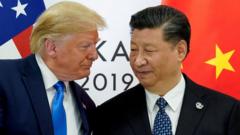A newly articulated financial strategy from China hints at shifting the dynamics of global commerce.
China Pushes for a Multi-Currency Financial System

China Pushes for a Multi-Currency Financial System
China's central bank governor critiques the dominance of the U.S. dollar, advocating for a diversified global currency framework.
In a bold move directed at reshaping the global financial landscape, Pan Gongsheng, the governor of the People’s Bank of China, unveiled a vision advocating a multi-currency system during the Lujiazui Forum held this Wednesday in Shanghai. This plan is a veiled response to the prevailing dominance of the U.S. dollar, as China intensifies its efforts to diminish its influence.
While Mr. Pan refrained from directly naming the dollar, his address resonated with implicit concerns regarding the sustainability of relying solely on one nation's currency. He highlighted potential vulnerabilities linked to fiscal and regulatory obstacles faced by countries that issue the world's primary currency. "The risks associated with a singular currency can culminate in heightened financial instability and could even precipitate an international crisis," he articulated.
This critique aligns with observations from the Trump administration, which previously advocated for a weaker dollar as a strategy to revive U.S. exports. Recently, the dollar has experienced significant devaluation, dropping by approximately 11 percent against the euro this year. Such a decline could potentially alleviate the persistent U.S. trade deficit, although it raises questions regarding the elevated cost of government borrowing in light of surging federal budget deficits.
As China's central bank continues to innovate within a changing economic framework, the implications of these developments could reverberate across global markets, influencing currency strategies and international trade dynamics in the years to come.
While Mr. Pan refrained from directly naming the dollar, his address resonated with implicit concerns regarding the sustainability of relying solely on one nation's currency. He highlighted potential vulnerabilities linked to fiscal and regulatory obstacles faced by countries that issue the world's primary currency. "The risks associated with a singular currency can culminate in heightened financial instability and could even precipitate an international crisis," he articulated.
This critique aligns with observations from the Trump administration, which previously advocated for a weaker dollar as a strategy to revive U.S. exports. Recently, the dollar has experienced significant devaluation, dropping by approximately 11 percent against the euro this year. Such a decline could potentially alleviate the persistent U.S. trade deficit, although it raises questions regarding the elevated cost of government borrowing in light of surging federal budget deficits.
As China's central bank continues to innovate within a changing economic framework, the implications of these developments could reverberate across global markets, influencing currency strategies and international trade dynamics in the years to come.






















